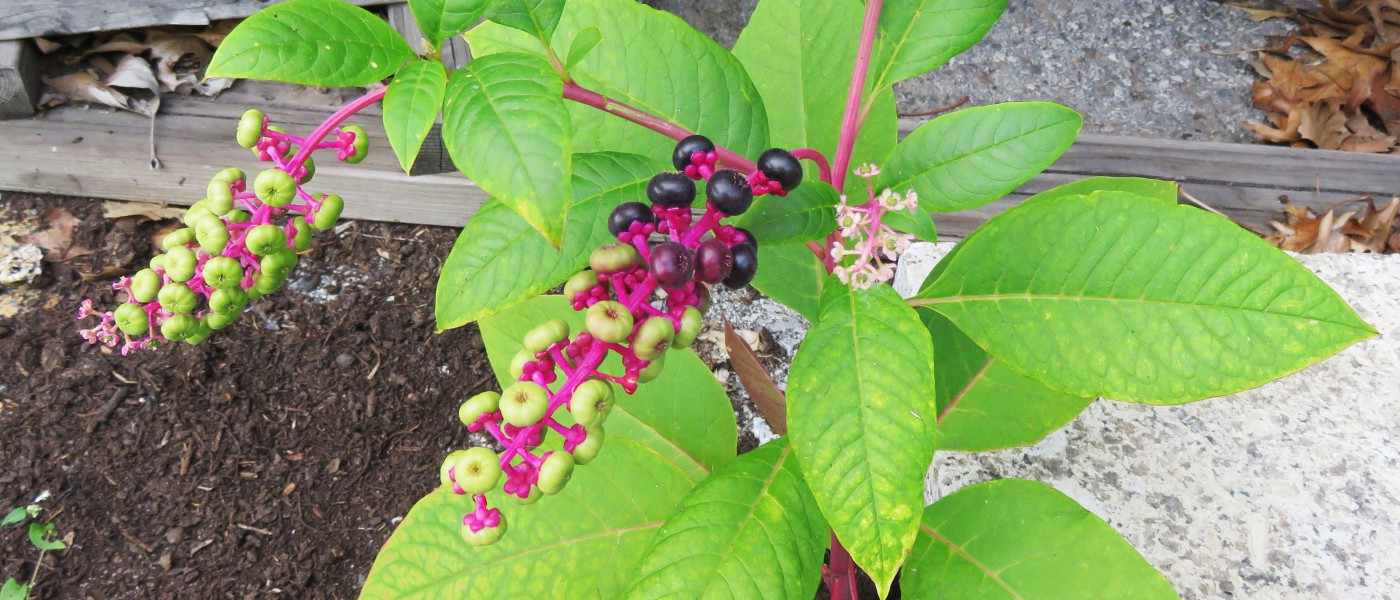Weed of the Month: Pokeweed
Every year around midsummer, a yellow-green shoot emerges in the same spot near the Children’s Garden sign. When its stem thickens and turns red over the next few weeks, I know that our beloved pokeweed (Phytolacca americana) is back! By this time of year, this herbaceous perennial resembles a small tree—some years it grows over six feet tall—and has clusters of shiny, dark purple pokeberries hanging from its stems. You will also see this distinctive, berry-laden plant in parks, empty lots, and inevitably in some gardens.
Native to the East Coast, pokeweed is one of the few urban weedy plants that was not brought here from Europe or Asia. The name “poke” most likely comes from the Algonquian word pokan, meaning bloody. The dark magenta juice from the berries has proven to be an effective writing ink as well as fabric dye. Some sources claim that pokeweed ink was used to write for the Declaration of Independence, but according to the National Archives, it was actually written with iron gall ink.
The whole pokeweed plant is considered poisonous from root to fruit, but that hasn’t stopped people from eating it! In the South, the young shoots and leaves are parboiled to create what’s known as poke sallet. The youngest leaves contain the least toxins, and the process of boiling them repeatedly in clean water effectively cooks the toxins out. It may seem like a lot of work, but pokeweed is a free and readily available source of nutrition. Famed Ozark chef and foraging expert Billy Joe Tatum included seven different poke recipes in her classic Wild Foods Cookbook and Field Guide and called it “far more delicious than most garden vegetables.” Until fairly recently, you could even buy canned poke sallet at the grocery store. The Arkansas-based company that canned it had to discontinue it in 2000, apparently because they couldn’t find enough suppliers (a.k.a. backyard poke pickers). Pokeweed aficionados have found ways to detox the berries, too, cooking only the mature fruit and deseeding them to make syrups, jams, and pie fillings.
Around here, it’s usually only feathered foodies that consider pokeberries edible. As fall arrives, the abundant fruits ripen to a dark purple and become palatable to many birds, which go on to disperse the seeds. This is why pokeweed is often found along fences and under power lines, just beneath the spots where those same birds perch. There are at least 30 bird species that rely on pokeberries as a major food source. Catbirds, wood thrushes, hooded warblers, and other migratory birds eat them to fuel their southward flights to warmer climes. Mockingbirds, cardinals, cedar waxwings, and other winter residents rely on the berries to get through the food-scarce winter ahead. So perhaps give pokeweed a pass when you’re weeding. Our hungry avian friends will thank you!


